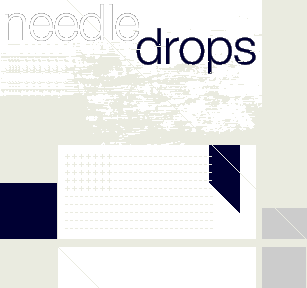


++ Contact Philip Sherburne ++
++ Recently ++
Tuesday, November 29, 2005 = The Stooges Unearthed (Again)
Tuesday, November 8, 2005 = Documenting Beulah And DCFC
Tuesday, November 1, 2005 = Out-Of-Control Rock 'N' Roll Is Alive And Well
Tuesday, October 25, 2005 = Just In Time For Halloween
Monday, October 3, 2005 = The Dandyesque Raunch Of Louis XI
Monday, August 15, 2005 = The Empire Blues
Tuesday, August 9, 2005 = David Howie's Sónar Diary
Monday, July 25, 2005 = Hot Sounds For Summertime
Monday, June 27, 2005 = Overcoming Writer's Block At Sónar 2005
Monday, June 4, 2005 = Cool New Sounds To Download Or Stream
++ Needle Drops Archives ++
View full list of Needle Drops articles...
|
|
 |
Friday, October 4, 2002
++ Cheap, MEGO, Couch, G-Stone, And The Curious
Permutations Of Viennese Electronica
++ Infrastructure, infrastructure, infrastructure. Vienna, it seems, is all about infrastructure.
I'm here on a press junket sponsored by the Viennese Tourist Bureau, the ostensible purpose of which is to cover the release of dZihan and Kamien's new CD, Gran Riserva. The kickoff party features the Viennese duo, backed up by a live band complete with percussionists, full horn section, and a string ensemble flown in from Istanbul.
For the days leading up to the event, though, we've been shepherded around Vienna to take in the sights and get a sense of the place, and in the course of our tours and wanderings, I don't think I've heard any word more frequently than "infrastructure." The Viennese are exceedingly proud of their infrastructure, and why not? An ingenious re-routing of the Danube via a series of canals corrected persistent flooding problems around the turn of the century, and when much of central Europe lay under water this summer, Vienna remained dry as a teetotaler's wineglass.
The city itself is a story of perpetual reinvention, as is evident from the cutaway street in the city center displaying overlapping waterworks and foundations dating from Roman times. Preservationist policies have kept the inner city much as it looked in the 19th Century, save for the abundance of upscale shops outfitted with plastic signage and the gradual invasion of American companies like Starbucks (yes, there's a Starbucks, even here in the European capital of coffee culture). Only outside the Innerstadt do glass high-rises appear.
Some of the city's recyclings are particularly inspired. After the Anschluss, Hitler built four enormous flakturm, or anti-aircraft towers, in the city — nine-story cement blocks ringed with double sets of Mickey Mouse ears on which the big guns were mounted. In the postwar years, it became evident that the towers were indestructible, unless the surrounding neighborhoods were to sustain serious damage, and so they have been left as inadvertent monuments to a shameful era. Today, however, the interior of one of the towers is an aquarium, and the outer walls have been outfitted with rock-climbing handholds, allowing urban mountaineers to scale and belay up and down the Fascist facades. A little further out, four brick cylinders once used to store helium for fueling Zeppelins have been repurposed as shopping malls and apartment complexes; before this somewhat tacky renovation, they housed some of Vienna's earliest raves.
++ The raves have evaporated as completely as the helium, but electronic music culture has dug into unlikely places here in Vienna. Rhiz, a popular bar and Internet café, known for hosting DJs from labels like MEGO and Cheap, sits beneath an arch along the raised railway. And Flex, a historic nightclub where in the space of a week I saw leading Viennese musicians Patrick Pulsinger, Philip Quehenberger, Sugar B, and a Sofa Surfers side project, began as a squat way out in the Meidling district before moving to the city center, where it inhabits a cavernous space on the embankment of the Donaukanal. (And talk about infrastructure: Viennese musicians can't say enough about the merits of Flex's sound system, and with good reason: the entire stage, it seems, is one enormous subwoofer. Stereotyp swears that it can make your vision blur, if turned up loud enough.)
Most surprising, though, might be the degree of official support the city affords electronic music, and the unlikely juxtapositions that have developed. After all, the name the tourist board has given this trip is "Vienna Hype: Electronic Music and Contemporary Art;" the government is clearly keen to take advantage of the strong, autonomous scene that has developed over the past decade or more. As a result, the new Museums Quartier, a complex of museums housed within a grand baroque palace grounds, hosts a shop for the ultra-underground Cheap label, studios for Werner Dafeldecker's Polwechsel project, as well as temporary gallery spaces for artists like Vienna's art pranksters Monochrom and Parisian fashion team Wendy and Jim. A trip to MICA (Music Information Center of Austria) indicates the kind of infrastructure that exists here to support artists: open to the public as a kind of Vienna showcase, the center offers consulting and advocacy services for all Austrian musicians, and is at work on a massive database of all Viennese popular music. (The physical archive lives for the moment in Quartier21, the new media space of Museums Quartier, and a peek inside the storeroom should quicken the pulse of even the most casual fan of Vienna's output: here, at last, you can gaze ever so fleetingly on that long-vanished copy of Fennesz' Instrument EP!)
++ Not everyone desires the status afforded by the official imprimatur of the museum establishment; Peter Rehberg, AKA Pita, is leery of the "multiplex" character of the place, where one night a Bryan Ferry concert took place next door to an experimental dance performance. And it's understandable that someone in his position would be hesitant to invest hard-won cultural capital in such an "aboveground" project. Rehberg and his partners, Ramon Bauer and Andy Pieper, have spent nearly a decade building their label, MEGO, into a self-sustaining operation. Today, supported by the online shop www.mdos.at and a roster including Fennesz, Farmers Manual, Pita, Sluta Leta, Jim O'Rourke, Kevin Drumm, Merzbow, Tujiko Noriko, and more, the resolutely DIY organization employs a handful of people and stands as one of the most respected forces in experimental music worldwide.
MEGO exemplifies the way that the DIY ethic has flourished here in Vienna; the city is full of cottage-industry imprints and independent artists, many of them active since the early 1990s. Best known, of course, are Kruder and Dorfmeister and their G-Stone label; along with artists like Vienna Scientists, they're largely responsible for raising Vienna's reputation worldwide, especially as a center for dubwise downtempo. There's plenty of that here: the Dub Club, a weekly staple for 10 years or more, has fostered any number of artists working in the slow-mo vein that this relaxed city seems to favor.
Couch Records' dZihan and Kamien work in similar fashion, though they outfit their grooves with a rich palette of Middle Eastern and Eastern European sounds. (I have heard many times on this visit that Vienna is the Easternmost city in Western Europe — or, alternately, the Westernmost city in the East. Its history as part of the Austro-Hungarian Empire has something to do with this, and its relative isolation — an overnight train from Berlin, for instance — has allowed things to incubate at their own pace, and with their own characteristics.) Like dZihan and Kamien, G-Stone's Stereotyp pursues downtempo with an ausländer edge. Moving on from Kruder and Dorfmeister's dubby crawl, he's taken dancehall reggae as his primary influence, and his tracks jump and crackle beneath the growls and crooning of Jamaican, Viennese, and American MCs like Tikiman, Sugar B, Cesar, and Collage. His newest work, which I managed to coax him to play for me in his studio, has the swing of Timbaland, the bite of Horsepower Productions, and the grainy eroticism of D'Angelo. It's fierce, fierce stuff.
++ But downtempo is hardly the only flavor in Vienna. Somewhere between G-Stone's stoned downtempo and MEGO's eclectic extremism are a host of artists experimenting with various forms of techno and electro. Pulsinger and Tunakan's Cheap label has been an international force for years now; their itchy, offbeat electro-techno laid down significant pieces of the electroclash foundation. Sabotage, another label-cum-art-collective, fostered much of the 1997-98 electro revival with records from Pomassl and EPY, as well as the Electro Juice compilation, forging links in these years with Detroit labels like Ersatz Audio and Interdimensional Transmissions. (Sabotage's art projects are far less conventional. For one of their more audacious projects they produced a perfume, called "Cash," modeled on the smell of a new $100 bill. This past summer, to coincide with Kassel's Documenta festival, they distributed hundreds of thousands of marijuana seeds to be planted in parks, gardens, and medians all over the city, in homage to Joseph Beuys. For their next intervention, Finland has ceded them an island on which to found a sovereign state for two years, during which time they plan to host summits for other "microstates" like Sealand and Elgaland and Vargaland.)
Gerhard Potuznik, who has recorded for Cheap, Ersatz Audio, Interdimensional Transmissions, and more, is perhaps the most retro of the retro-electricians. His new single for Canada's Suction, "Vendetta," is based upon two tracks begun in 1996, and they sound it: all arpeggio and swoony vocals, they're dead ringers for classic New Order and Depeche Mode. He's hardly a one-trick artist, though: his new label Angelika Koehlermann specializes in Japanese quirk and unclassifiable pop projects. It's one of the more refreshing collections of music to come along in ages.
Tomorrow, bringing things full circle, I'll see Pita with the D.A.C.M. presenting Showroom Dummies, a dance/performance piece based on mannequins and set to Pita's planar soundscapes, at the Museums Quartier's Tanzquartier. Rehberg may have his reservations about the "mallification" of culture, but it's hard to argue with an institution that willingly plays host to an event like that, even if Bryan Ferry is holding down the establishment set next door. Besides, one can always drop a dab of Cash on one's wrist, as a reminder of the curious permutations of culture, capital and infrastructure.
|
| |
|